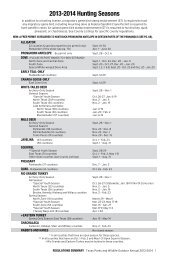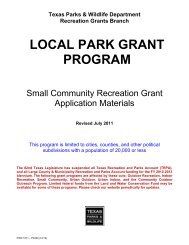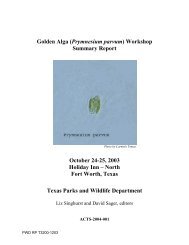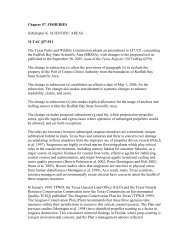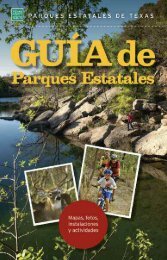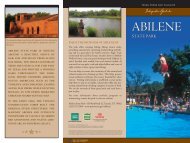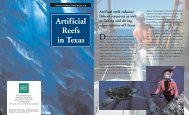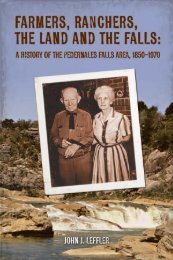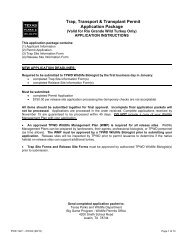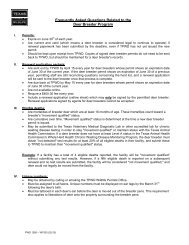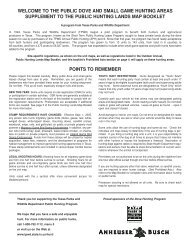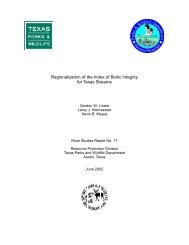1-1 Appendix 1 Responses to survey questions administered to ...
1-1 Appendix 1 Responses to survey questions administered to ...
1-1 Appendix 1 Responses to survey questions administered to ...
You also want an ePaper? Increase the reach of your titles
YUMPU automatically turns print PDFs into web optimized ePapers that Google loves.
• The greatest strength of the standardized assessment procedure is having a<br />
stratified random design for selecting sampling stations. This avoids bias in<br />
determining catch estimates.<br />
• I believe the procedures in itself are great IF ALL ARE DONE CORRECTLY.<br />
• Not sure<br />
• Weakness – Difficulty of addressing <strong>questions</strong> that deal with species or issues<br />
that the procedure is not designed <strong>to</strong> assess. For example, natural resource<br />
management issues dealing with species rarely encountered in a given<br />
standardized sampling program.<br />
• Weaknesses: Standardized assessment procedures directed at the entire resource<br />
may not provide adequate data for all species. (However, appropriately directed<br />
special studies should fill data gaps when needed.)<br />
• Although focus on game fish is important, the ecosystem that supports the game<br />
fish (early life his<strong>to</strong>ry of game fish, non-game fish, invertebrates, zooplank<strong>to</strong>n,<br />
and phy<strong>to</strong>plank<strong>to</strong>n) has been relatively unexamined. To successfully manage the<br />
game fish in the long term, we must understand more of the complete ecosystem.<br />
Game fish are not independent of the ecosystem as a whole.<br />
• Do not account for differences in variety of habitats (benthic versus pelagic,<br />
random sampling design versus need for sampling specific areas or reefs equally<br />
over time)<br />
• The greatest weakness is that such strict adherence <strong>to</strong> a specific set of pro<strong>to</strong>cols<br />
prevents us from recognizing and changing pro<strong>to</strong>cols <strong>to</strong> better and more<br />
efficiently assess the status of the resource. We also concentrate our efforts and<br />
resources on analysis of only recreationally or commercially important species<br />
rather than utilizing additional “indica<strong>to</strong>r” species <strong>to</strong> better determine the overall<br />
ecosystem status.<br />
• Status quo. Do it this way because that’s the way we always done it. Resistance<br />
<strong>to</strong> change.<br />
• Our biggest shortcoming is the apparent unwillingmess <strong>to</strong> re-evaluate some of the<br />
standardized sampling schemes <strong>to</strong> either increase or decrease sample size <strong>to</strong> allow<br />
for special studies sampling.<br />
• The greatest weakness might be a lack of communication with other agencies or<br />
universities <strong>to</strong> update these procedures.<br />
• The greatest weakness is not having a study of gear selectivity <strong>to</strong> coincide with<br />
the assessment. Understanding gear selectivity and efficiency is a vital component<br />
of analyzing fish populations in an independent moni<strong>to</strong>ring study such as the one<br />
employed at TPWD.<br />
• Specific Weakness: Oyster dredge CPUE is underestimated – the number of<br />
dredges taken <strong>to</strong> obtain shell is not recorded.<br />
• Weakness – bad procedures, like using a very small net <strong>to</strong> sample the Gulf, have<br />
been institutionalized.<br />
• Weakness: Commercial landing estimates are based on a self-reporting system<br />
which is based on trust and assumptions and lacks quality assurance.<br />
2-11



